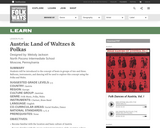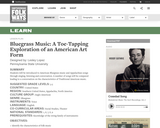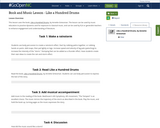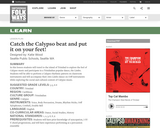
Students will be able to effectively recognize and imitate AB binary form through movement.
- Subject:
- Arts Education
- Music
- Material Type:
- Lesson Plan
- Provider:
- Teachers.Net
- Author:
- Meghan Webb
- Date Added:
- 02/26/2019

Students will be able to effectively recognize and imitate AB binary form through movement.

Students will listen to Copland's Appalachian Spring while listening to a reading of Heartland by Diane Siebert. They will then write their own poems and create accompanying artwork.

Students will discover how the love of music connected two important figures in world history: Benjamin Franklin, an American founding father, and Wolfgang Amadeus Mozart, an Austrian composer. Additionally, students will begin to understand pitch, and how each note is calibrated to create its own unique sound.

Students will generate descriptive language of several animals (with special focus on verbs), culminating in the writing of a poem about the animal of their choice. Use Saint-Saens' Carnival of the Animals as a stimulus prompt.

Students will learn about Italian artist Giuseppe Arcimboldo, his mannerist style, and his four paintings named after the four seasons. Students will learn about the food groups and the four seasons. Students will learn about Italian composer Antonio Vivaldi and his compositions named after the four seasons.

Students will be introduced to the concept of beats in groups of two and three. Balloons, instruments, and dancing will be used to explore this concept using Polka and Waltz.

Students work in groups to learn and perform a piece on non-pitched percussion instruments and develop rhythm reading and ensemble skills.

Students will gain an understanding of meter by experiencing accented and unaccented beats. This free lesson plan is designed to fulfill Standard #5 of the National Standards for Music Education: Reading and notating music.

This lesson develops students' ability to hear subtle dynamic levels in orchestral music, and to recognize
sudden and gradual differences. They will use their collective perception to make relative aural judgments
about levels and changes. Data will be recorded on a bar graph marking real time and 6 dynamic levels
roughly equivalent to 6 primary markings of standard dynamics: pp to ff.

Students discover how music can create a visual image in one"™s mind as they listen to Beethoven"™s Sixth Symphony "“ Pastoral. As the image takes shape, the students create a visual representation of their image to include the aspects of nature which Beethoven included in this wonderful composition.

Students write a descriptive essay explaining their thoughts and feelings while listening to Beethoven"™s 5th Symphony, learning how to describe the musical elements that cause them to feel this way, and transpose these feelings into a watercolor art piece. The students will present their essay and art work orally, and act out their responses during a physical education exercise.

Students will be introduced to American Bluegrass music and Appalachian songs through singing,
listening and conversation. A number of songs will be compared leading to a conversation on the
characteristics of Traditional American music.

This lesson uses the book, Like a Hundred Drums, by Annette Griessman. The lesson can be used by music educators to practice dynamics and for exposure to classical music, and can be used by ELA or generalist teachers to enhance engagement and understanding of literature.

Students will complete two language arts activities for this lesson. In the first activity, students use folk
songs from the era of the California Gold Rush, which are introduced in the early chapters of By the Great
Horn Spoon! by Sid Fleishman, to identify folk song motifs in the classical music of AntonÃn Dvořák. This
will be explored by the students' creation of a labeled line drawing of one of Dvořák 's compositions. In the second activity, students will write a letter to Dvořák from the point of view of Master Jack, a character in Fleishman"™s novel, inviting Dvořák to continue his American tour into the gold fields of California for
musical inspiration.

Students will explore creating moods with music. Students will assimilate this new knowledge through the analysis of a story and the creation of a musical composition that reflects and enhances it. This activity will culminate with the recording of their musical accompaniment and story to produce a book on tape.

Students will travel to the island of Trinidad to explore the feel of Calypso music and participate in a Trinidadian popular dance, the Limbo. Students will be able to perform a Calypso rhythmic pattern on classroom instruments and will accompany their own Limbo dance on Orff instruments while exploring the social and cultural context of Calypso music.

Students will explore the lives of various jazz musicians. They will become familiar with the social and historical events that were present during the lives of these individuals. They will listen to the music of the artists and become knowledgeable about their styles. This activity will culminate in the production of a news/talk show created and performed by the students highlighting the lives of these musical figures.

Students are introduced to Johann Sebastian Bach"™s music through short deep listening exercises and
optional integrated language arts activity.

The Paraguayan harp is a cultural emblem that represents not only the nation of Paraguay and its
traditional music, but also the ideals that contribute to a collective notion of paraguayidad (i.e.
"Paraguayness"). The Paraguayan diatonic harp serves as a melodic, harmonic, and rhythmic
instrument. Its primary function is to provide harmonic and rhythmic foundation to conjunto
music"”music of a variety of instruments. At the heart of Paraguayan harp repertoire are polcas
paraguayas, guaranias and polca galopas all genres within the body of musical expressions in
Paraguay. This lesson is divided in three segments that describe three colorful styles of
Paraguayan music: the polca galopa, the guarani and the polca paraguaya

Students will create a visual representation of what they think about, or feel from the music of Copland and Stravinsky. After reading books from the series Getting to Know the World's Greatest Composers, students will use a Venn diagram to compare and contrast the two composers, their music, and the time period in which they lived.